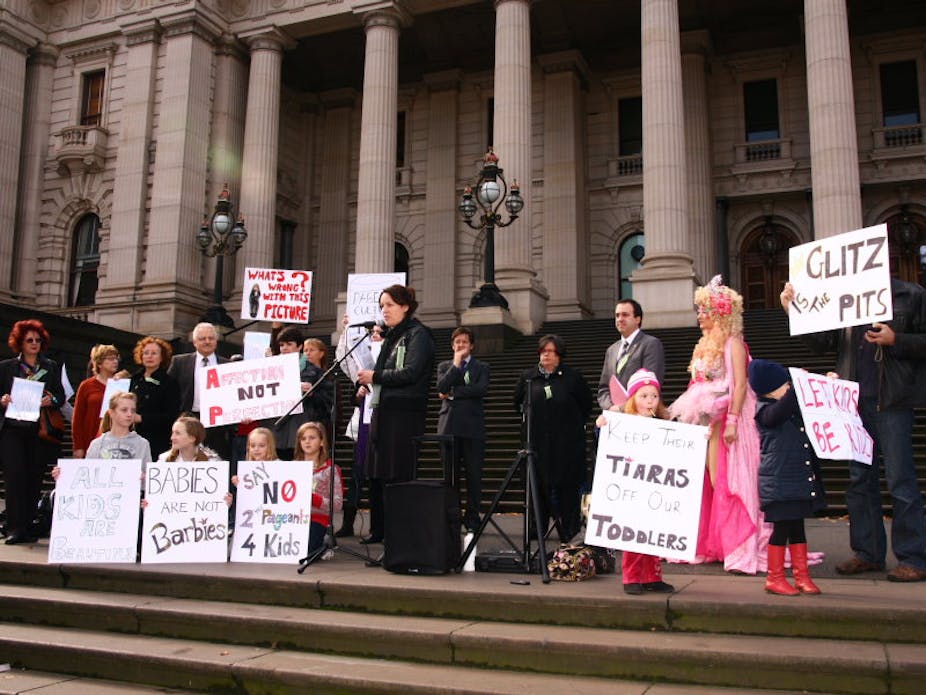The Universal Royalty Beauty Pageant, who brought us the television show Toddlers and Tiaras, is just days away from its inaugural Australian meeting in Melbourne, and there’s been a build-up of public opinion heralding a fatal assault on childhood innocence.
It seems there’s little that makes Australians more queasy, confused or outraged than a child in a tiara.
One article in The Australian (June 25, 2011), provocatively titled “Primp or Pimp,” cites parents, psychologists and children’s rights groups, who, the story states, all share the concern that “the pageants exploit children, damage their self-esteem and can even lead to mental illness.” Strong claims indeed.
Another in The Age (May 24, 2011) is ill at ease, but less emphatically so.
It calls “kiddie” pageants “creepy,” and suggests a general discomfort with the uncanny likeness between child beauty queens and dolls. And it expresses a concern about the Americanisation of Australian culture the importation of child beauty pageants epitomizes.

But the article’s most quotable advice from an expert – ethicist Lesley Cannold – is that the pageants are “really odd.”
Let me confess that I also find pageant culture oddly fascinating. There is something unnerving about the perfection and control of grooming and performance, and the sickly sweetness of that particular aesthetic.
And, yes, I find such unabashed objectification of girls intuitively grotesque.
But I also think we need to examine our own passionate responses to child pageants, and to the children in them.
What is it precisely that haunts us in that image of Eden Wood, for instance, most frequently displayed to establish the “creepiness” of the pageant enterprise?
I suspect the disgust provoked by child pageants reflects more than a concern for children: these reactions are symptomatic of broader and more diffuse anxieties that implicate and affect us all. But they feel more urgent when reflected in images of children.

Pageants crystallise worries about child sexualisation that have emerged in recent years. Concerns about children in advertising have now become a familiar refrain, and a hot-button issue for politicians looking to garner public sympathy.
Sexualisation is endemic though and the child pageant is just a stark reminder of adults’ discomfort with the sexual displays that permeate our culture generally.
Associating children with make-up and desirability incites uneasiness and fear: it creeps us out. But we should be cautious not to associate the child beauty queen with sexual precocity – as headlines like “Primp or Pimp” risk doing.
Child pageants also monstrously echo back to us an intimate, regrettable and growing connection between childhood and consumerism.
Parents often feel acute responsibility as custodians of their children’s consumerist desires: the perpetual conflict between what we want and what’s good for us epitomised by the tantruming child.
Because pageants involve such conspicuous consumption, they provoke this distress about the convergence of childhood and consumerism.
Pageant parents spend exorbitantly on dresses, hair, make-up and comportment. These events are a multi-million dollar industry — and companies like the Texas-based Universal Royalty also turn a healthy profit through subsidiary enterprises, such as modeling lessons.
But the deal breaker for many is the child’s role in the generation of profit: these girls are so hard-working and disciplined that it’s difficult to take seriously pageant-industry claims that it’s all fun and games.
And, perhaps more to the point, these working children jar against aspirations to keep childhood separate from what are seen in contemporary Australia as “adult” concerns.

Pageants not only offend against the value of moderation in consumption then, but also our sense of who should perform labour that produces profit.
So a lot hangs on the claim that for the children, pageants are a form of play.
But, finally, the horror of child pageants points to something many wouldn’t like to confess: a sense of class distinction.
The working class are frequently stereotyped as immoderate consumers and as sexualised — as not understanding how to spend their money or exercise discretion — and parodies such as Vicky Pollard, or the “cashed-up-bogans” Kath and Kim, veil this contempt only thinly.
Child pageantry offends because of its bad taste as much as its presumed immorality.

Children have become a stage for the triumph of middle-class values, and increasingly morality is policed in relation to their presentation.
The rule is that children should represent a purity from desires – both consumer and sexual – not embody them.
Yet, ironically, because children are so constantly scrutinized for signs of over-consumption and sexualisation, it is becoming increasingly difficult to separate them from it. In the public imagination, children are coming to embody these vices.
Railing against child beauty pageants does little to address what’s really at the heart of our qualms about them: pageants are so horrifying because they represent excesses good middle-class citizens attempt so diligently to keep in check.
What’s more, they take place precisely at the point where we imagine freedom from desire – childhood.
Clearly more insight is needed into children’s role in mediating dissatisfaction in the “adult” world.

